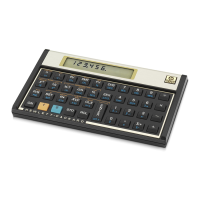Section 4: Additional Financial Functions 69
6. Press:
z fV for depreciation using the straight-line method.
z fÝ for depreciation using the sum-of-the-years digits method.
z f# for depreciation using the declining-balance method.
V, Ý, and # each place the amount of depreciation in the display. To
display the remaining depreciable value (the book value less the salvage value)
after the depreciation has been calculated, press ~.
Example: A metalworking machine, purchased for $10,000, is depreciated over
5 years. Its salvage value is estimated at $500. Find the depreciation and
remaining depreciable value for the first 3 years of the machine’s life using the
declining-balance method at double the straight-line rate (200 percent
declining-balance).
To calculate depreciation and the remaining depreciable value when the
acquisition date of the asset does not coincide with the beginning of the fiscal
accounting year, refer to the procedures in Section 13. That section also includes
a procedure for depreciation calculations when changing from the
declining-balance method to the straight-line method, and a procedure for
calculating excess depreciation.
Keystrokes Display
10000$
10,000.00
Enters original cost.
500M
500.00
Enters salvage value.
5n
5.00
Enters expected useful life.
200¼
200.00
Enters declining-balance factor.
1f#
4,000.00
Depreciation in first year.
~
5,500.00
Remaining depreciable value after
first year.
2f#
2,400.00
Depreciation in second year.
~
3,100.00
Remaining depreciable value after
second year.
3f#
1,440.00
Depreciation in third year.
~
1,660.00
Remaining depreciable value after
third year.

